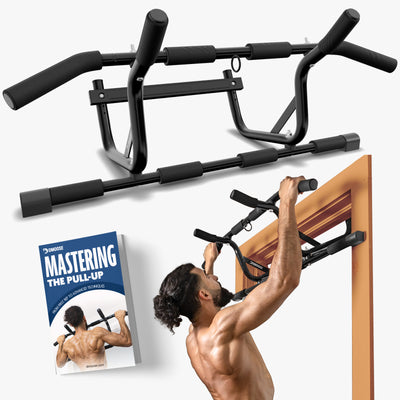Building a strong, muscular back can feel like a challenge, especially when you're unsure which exercises yield the best results.
With countless options and techniques out there, it's easy to feel overwhelmed or stuck in routines that fail to deliver noticeable progress. The key lies in choosing the right exercises and executing them with proper form and technique.
Incorporating a Door Frame Pull Up Bar into your setup is also a simple yet powerful way to support vertical pulling movements at home.
Fortunately, renowned hypertrophy experts Dr. Mike Israetel and Jared Feather recently coached fitness trainer Eugene Teo through a powerful back workout, sharing their insights on what truly works.
Their advice has inspired this post, where we’ll focus on three game-changing exercises to help you build a thicker, stronger back. Along with practical tips, we’ll also explore how to optimize these exercises for your training goals, ensuring you get the most out of every rep.
3 Best Exercises for Back Training
These three exercises are non-negotiable for creating a balanced back that supports strength and aesthetics. They target all the major back muscles, including lats, traps, and spinal erectors.
1. Pull-Ups

Pull-ups are the ultimate compound exercise for building upper body strength and back width. They engage your lats, traps, rhomboids, and biceps, making them a well-rounded movement for both strength and hypertrophy.
Beyond aesthetics, pull-ups improve functional fitness by enhancing grip strength and overall stability. They are versatile and can be adapted for different fitness levels, making them a staple in any training program.
Whether you're a beginner or an advanced athlete, mastering pull-ups ensures a solid foundation for your back workout. Consistency and proper form are essential to reap the full benefits of this challenging yet rewarding exercise.
How to Perform Proper Pull-Ups
- Grip the bar with your palms facing away, slightly wider than shoulder-width.
- Pull your body upward until your chin clears the bar.
- Lower yourself slowly to the starting position, focusing on the eccentric phase.
Expert Tip: Avoid kipping or swinging; maintain strict form to engage the target muscles fully.
The DMoose Doorway Pull Up Bar provides a reliable, space-saving solution for perfecting your pull-ups at home.

2. Lat Prayers

Lat prayers are a focused isolation exercise designed to enhance lat development and create the coveted V-taper physique. This movement emphasizes both the stretch and contraction phases, targeting the latissimus dorsi for optimal muscle growth.
By removing assistance from other muscle groups, lat prayers ensure maximum engagement of the lats, making them an excellent choice for lifters seeking more definition and symmetry. This exercise is particularly effective for reinforcing the mind-muscle connection, a crucial aspect of hypertrophy training.
It’s a simple yet powerful addition to your routine, delivering noticeable results when performed with precision and consistency.
How to Perform Lat Prayers
- Start with your arms extended overhead, gripping a cable attachment.
- Pull the bar straight down toward your hips, keeping your arms straight.
- Slowly return to the starting position, ensuring a deep stretch at the top.
Pro Tip: High elbows and a controlled movement emphasize the stretch and contraction of your lats.
Related Article: Back Workouts for Women: 8 Best Back Exercises to Build Muscle
3. Smith Machine Flexion Rows

Smith machine flexion rows are a powerhouse exercise for building back thickness and overall strength. This movement uniquely targets the lats, spinal erectors, and mid-back muscles while engaging stabilizers for a comprehensive workout.
The controlled range of motion on the Smith machine allows for safer execution, making it ideal for lifters of all levels. By incorporating a deep stretch at the bottom and a strong contraction at the top, flexion rows maximize muscle activation across your entire back.
They’re perfect for improving posture, enhancing spinal mobility, and developing the strength needed for other compound lifts and athletic movements.
How to Perform Smith Machine Flexion Rows
- Position the barbell on the Smith machine and place weight plates beneath your feet to increase the range of motion.
- Start with your hips steady, curl your spine, and allow your back to stretch at the bottom of the movement.
- Arch your back and lift your chest high at the top to achieve a full contraction.
- Maintain control throughout to activate stabilizer muscles and strengthen your back across all ranges.
For added support, try the DMoose 5mm Weightlifting Belt to protect your lower back during heavy lifts.
Sample Back Workout Routine

This incredible back workout, suggested by Dr. Mike Israetel and Jared Feather, is designed to target all major back muscles while optimizing strength and muscle growth.
Drawing on their expertise in hypertrophy training, this routine ensures you achieve maximum results with proper technique and muscle engagement. Here’s how to incorporate their recommended exercises into your training plan:
- Warm-Up: Pull-downs – 3 sets of 12–15 reps
- Strength Builder: Pull-ups – 3 sets to failure
- Isolation Exercise: Lat Prayers – 3 sets of 12–15 reps
- Mass Builder: Smith Machine Flexion Rows – 4 sets of 8–10 reps
- Cool-Down: Foam rolling and stretching
By following this expertly crafted routine, you’ll develop a stronger, more muscular back while enhancing your overall training performance.
Related Article: The Ultimate 12-Week Back Blasting Workout Plan
Tips for Effective Back Training
Prioritize a Thorough Warm-Up
Warming up is crucial for preparing your muscles and joints for a demanding back workout. Dynamic stretches and light exercises like pull-downs help increase blood flow, activate your lats, and reduce the risk of injury. Take 5–10 minutes to ensure your body is ready to perform at its best.
Emphasize Eccentric Movements
The lowering phase of an exercise, known as the eccentric phase, is a key driver of muscle growth. Slow and controlled eccentric movements create tension, promoting hypertrophy and enhancing strength. Focus on this phase for better results in exercises like pull-ups and rows.
Use the Right Equipment
Gear can make a significant difference in your performance and comfort. If grip fatigue is limiting your sets, invest in DMoose Lifting Hooks to maintain a secure grip and target your back muscles more effectively.

Perfect Your Form
Maintaining proper technique is essential for targeting the right muscles and avoiding injuries. Avoid using momentum or swinging during exercises, as this shifts the focus away from your back. Controlled, deliberate movements ensure full engagement of the target muscles.
Incorporate Variety in Your Workouts
Engage different areas of your back by including a mix of compound and isolation exercises. Combine pull-ups, rows, and lat prayers to target the lats, traps, and spinal erectors effectively. Varying angles and grips can further enhance muscle activation and prevent plateaus.
Avoid These Common Back Training Mistakes
Using Momentum
Dr. Mike Israetel and Jared Feather recommend avoiding momentum during exercises like pull-ups and rows. Swinging your body not only reduces effectiveness but also increases injury risk. Focus on slow, controlled movements to fully engage your back muscles.
Ignoring Range of Motion
According to Dr. Mike Israetel, completing the full range of motion ensures optimal muscle activation and growth. Half-reps may feel easier but limit your results. Commit to full, proper movements for better hypertrophy.
Neglecting Form
Both experts emphasize the importance of perfect form. Poor technique shifts focus away from your back muscles and can lead to strain or injury. Maintaining a neutral spine and controlled execution is key for safe, effective training.
Overloading Weights
Jared Feather advises against lifting weights that are too heavy for proper form. Overloading compromises technique and increases the risk of injury. Stick to manageable weights and progress gradually for sustainable growth.
Skipping Warm-Ups
Dr. Israetel recommends never skipping a warm-up. Properly preparing your muscles with dynamic stretches or light exercises like pull-downs primes your back for a safe, effective workout.
Related Article: How to Build an Effective Workout Program for You
FAQs
1. Why is back training important for overall fitness?
Back training improves posture, enhances overall strength, and reduces the risk of injury by strengthening key stabilizing muscles. A strong back also supports other compound movements like deadlifts and squats.
2. How many times a week should I train my back?
Experts like Dr. Mike Israetel recommend training your back 1–2 times per week, depending on your recovery ability and overall training split. Ensure adequate rest between sessions for muscle repair and growth.
3. Can beginners do pull-ups?
Yes, but beginners may need assistance to build strength. Start with resistance bands, assisted pull-ups, or negative pull-ups to develop the required muscle groups.
4. What’s the benefit of eccentric loading during back exercises?
Eccentric loading, or focusing on the lowering phase of a movement, creates more tension in the muscles. This leads to greater hypertrophy and strength development, making it a crucial aspect of effective back training.
5. Should I prioritize weight or form during back exercises?
Form should always take priority over weight. Using proper technique ensures you target the right muscles and avoid injuries. Gradually increase the weight as your form improves.
6. What equipment can enhance my back workouts?
DMoose Doorway Pull Up Bar and Lifting Hooks can help you perform exercises more effectively, reduce grip fatigue, and target your back muscles better. These tools make workouts more efficient and comfortable.
Conclusion
Building a strong, muscular back isn’t about doing every exercise in the book—it’s about choosing the right ones and executing them with precision. The workout designed and coached by Dr. Mike Israetel and Jared Feather is a testament to how effective a focused, well-structured approach can be.
Incorporating exercises like pull-ups, lat prayers, and Smith machine flexion rows into your routine ensures that you target every part of your back for balanced strength and impressive aesthetics. The key is consistency, proper form, and a willingness to push yourself to your limits.
Take the advice from these experts, apply it to your training, and watch your back gains soar.











